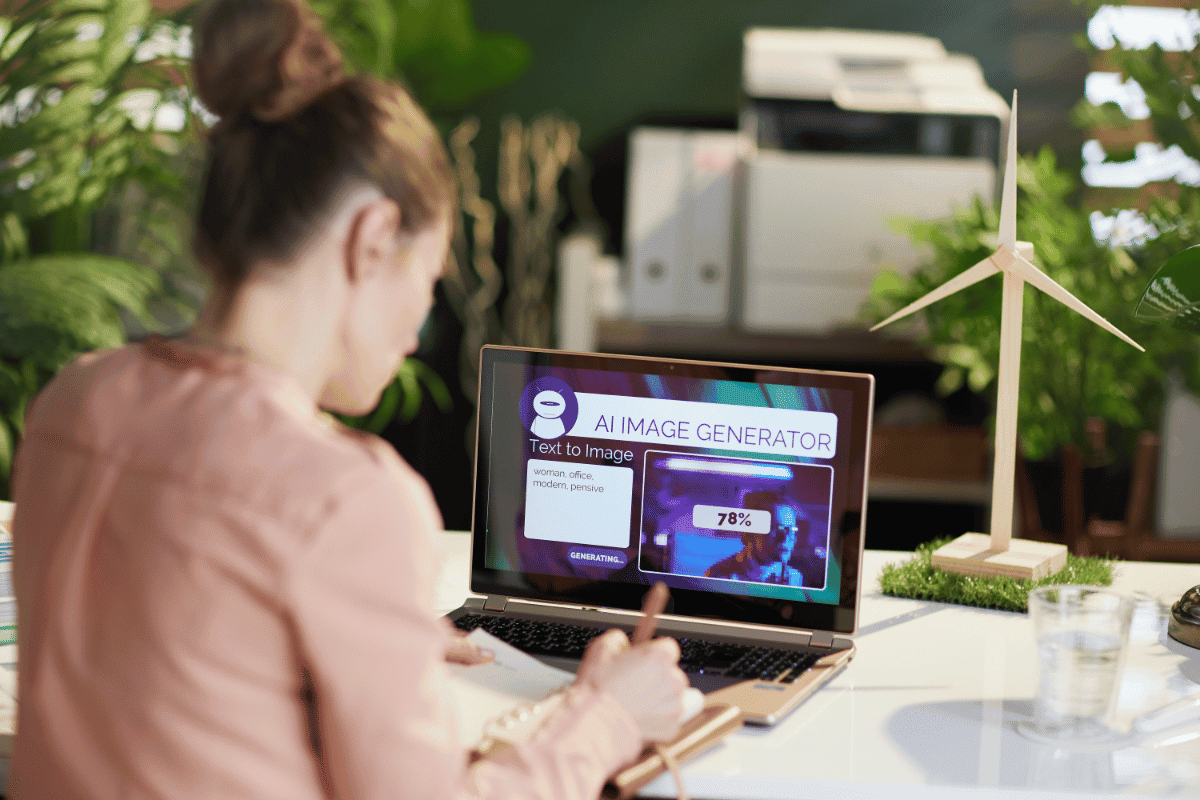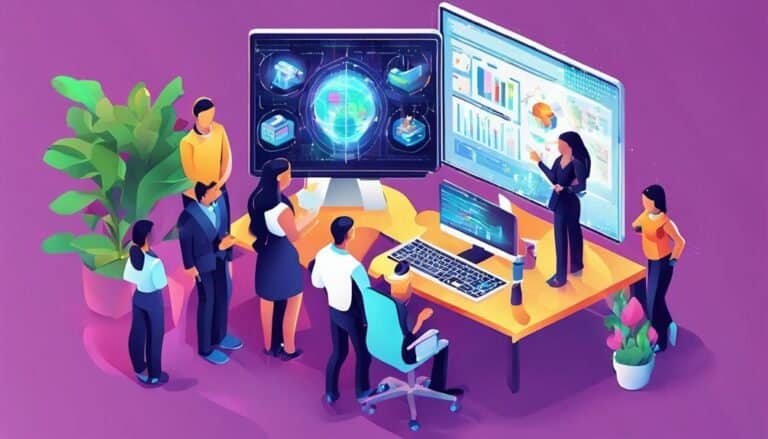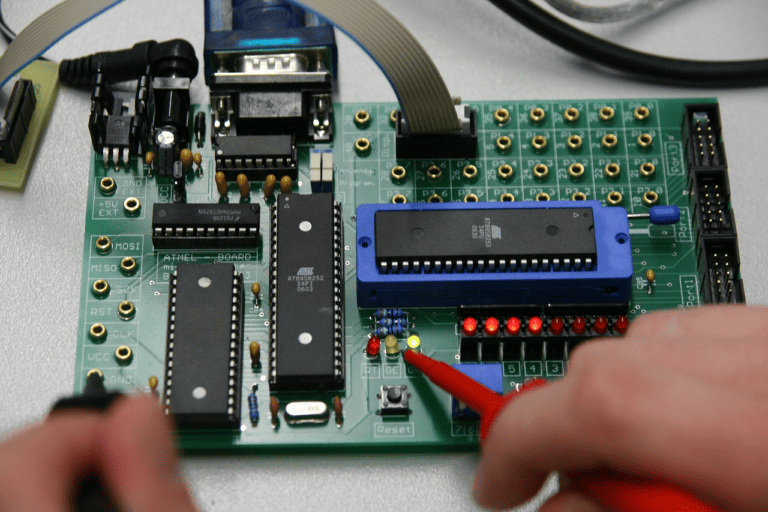Generative AI: How Will It Affect Future Jobs and Workflows?
|
Getting your Trinity Audio player ready...
|
In the fast-paced world of technology, you’re standing on the brink of another revolution – Generative AI.
It’s not just another buzzword; it’s an engine transforming industries and workflows. You’ve seen the impact of AI, but now it’s time to delve into the emerging realm of Generative AI.
This breakthrough could reshape your job, your industry, even your future. So, buckle up as we navigate the intricacies of this game-changing phenomenon together.
Key Takeaways
- Generative AI challenges the boundary between AI and human creativity by creating new content using machine learning.
- The quality of the output of generative AI depends on the training data and the use of generative algorithms.
- Generative AI has limitations in dealing with abstract concepts and context, leading to results that may lack coherence or realism.
- Despite its limitations, generative AI is widely used in various industries such as visual arts, journalism, music, gaming, advertising, and cybersecurity.
Understanding the Concept of Generative AI
Before we dive deeper, you’ll need to grasp what generative AI is and how it’s revolutionizing various sectors. Originating from the concept of machine learning, generative AI has evolved into a system capable of creating new content, from visual art to written prose. It’s a game-changer in the creative industry, challenging the traditional boundary between AI and human creativity.
But it isn’t all sunshine and rainbows. Despite its potential, generative AI has limitations. It can only create based on what it’s been taught, lacking the genuine inspiration that fuels human creativity. Also, the quality of its output heavily depends on the quality and quantity of its training data.
Moreover, it’s worth noting that while AI in art creation opens up a new world of possibilities, it also raises questions about intellectual property and privacy. Can an AI own a copyright? How do we ensure the data used for its training isn’t infringing on privacy rights?
Generative AI’s impact on privacy and its potential limitations are crucial considerations as we move into a future where AI could become a staple in our daily lives.
Stay tuned as we delve deeper into the implications of this emerging technology.
How Generative AI Is Different From Other AI Technologies
You often encounter AI technologies, but generative AI isn’t quite like anything you’ve seen before. As part of AI evolution, AI diversification has led to the emergence of generative AI. Its distinction lies in its generative algorithms, which allow it to generate new data from existing ones. Unlike traditional AI that responds based on programmed responses, generative AI uses its algorithms to create unique outputs, offering a whole new level of AI innovation.
However, this innovation comes with its dilemmas. Generative AI dilemmas arise from its potential to create ultra-realistic content. It could generate fake news or deepfakes, raising ethical and security concerns. But don’t let these issues overshadow its potential. Generative AI can be a game-changer for industries from entertainment to manufacturing, creating custom designs or personalized content.
The Mechanics Behind Generative AI
Diving into the mechanics behind generative AI, it’s crucial that you understand how it functions both on the surface and beneath it. At the heart of this AI evolution are generative algorithms – complex sets of rules that allow AI to create unique and original outputs. Be it text, images, or music, these algorithms can generate something new from existing data.
However, the journey of AI innovation hasn’t been without its AI limitations. Understanding these generative AI challenges is key to appreciating the complexity of the technology. For instance, AI struggles with abstract concepts and context, often producing results that lack coherence or realism. Despite these obstacles, the technology continues to evolve, finding ways around its limitations.
The mechanics of generative AI are intricate, but understanding them can give you a clearer picture of the AI landscape. It’s fascinating to see how AI is moving from being a tool for analysis to becoming a creator in its own right. As you delve deeper, you’ll see that the potential of generative AI is vast, but so are the challenges it needs to overcome.
Current Applications of Generative AI in Various Industries
Now that you’re familiar with the mechanics of generative AI, let’s explore its current applications in various industries, and how it’s revolutionizing workflows and job roles. The transformative power of Generative AI isn’t just hypothetical; it’s already making waves.
- AI Artistry: Artists are using AI to create unique and innovative designs, altering the landscape of visual arts and graphic design.
- Generative Journalism: AI’s capacity to generate content has led to its use in journalism, where it can churn out news reports quickly and efficiently.
- AI Composers: In the music industry, AI can compose original tunes, changing the game for songwriters and composers.
- Generative Gaming: Game developers use AI to generate complex and immersive gaming environments, taking user experience to the next level.
- AI Architecture: In the field of architecture, AI is used to generate design alternatives, improving efficiency and outcomes.
So, you see, generative AI isn’t just a concept anymore. It’s transforming industries, automating tasks, and opening up new opportunities for innovation and creativity.
The future of work with generative AI seems promising, don’t you think?
Potential Future Applications of Generative AI
Having looked at the current applications of generative AI, let’s gear up for an exciting ride into the future, where AI doesn’t just replicate human intelligence, but also innovates and creates in ways we can’t yet imagine.
AI-driven Creativity is a hot topic. Imagine AI tools that not only automate your tasks but also bring fresh creative ideas to the table. AI could revolutionize industries like advertising, where unique and innovative designs are the key to success.
Generative AI Security is another promising avenue. AI could proactively design cybersecurity systems, constantly evolving to outsmart threats. It’s a game-changer for businesses, making security more robust and less human-dependent.
AI in Entertainment has huge potential. Think personalized films, music, and art, generated on the fly to suit your tastes. Or Generative AI and Gaming, where AI designs new levels, characters, and plots, making gaming more immersive and dynamic.
Personalized AI Solutions could transform everyday life. Imagine AI that anticipates your needs, designing unique solutions for you, from planning your day to suggesting new recipes.
With Generative AI, the future isn’t just automated—it’s creative, secure, personalized, and entertaining. It’s a future you’ll want to be a part of.
The Impact of Generative AI on Work Processes
Interestingly, as you integrate generative AI into your work processes, you’ll not only enhance efficiency but also spark unprecedented AI-driven innovation. This technology is pushing the boundaries of what’s possible, enabling AI-based collaborations that can revolutionize your workflows.
Yet, despite its vast potential, it’s crucial to understand the Generative AI Limitations. It’s not a magic wand that solves all problems, but a tool that needs careful calibration:
- It can generate high volumes of data, but requires meticulous curation and cleaning.
- It can automate tasks, but lacks the human touch and instinctive judgment.
- It can speed up processes, but may face scalability issues as Generative AI’s Scalability is still a work in progress.
- It can create new solutions, but may inadvertently disregard ethical considerations.
However, with the right approach and understanding, Generative AI can be a game-changer, especially in the sphere of AI in Entrepreneurship. It can create new paradigms, enhance decision-making, and lead to groundbreaking products.
As you navigate this digital transformation, remember to balance the benefits with the limitations to fully harness the potential of Generative AI.
Generative AI and The Changing Job Landscape
You might be wondering how generative AI is shaping the job landscape, and it’s clear that this technology is altering roles, tasks, and skills in numerous industries. With generative algorithms at play, the fear of AI unemployment is simultaneously rising with the advent of AI-driven innovation.
While AI is transforming industries, it’s not all doom and gloom. Yes, certain tasks are being automated, but this also leads to AI job creation. As machines handle mundane tasks, you’ll notice new roles emerging that require human creativity, emotional intelligence, and strategic thinking.
Generative AI isn’t just about replacing human effort but enhancing it. For every job that becomes obsolete, there’s potential for several more to be created. For instance, AI-driven innovation could lead to the birth of roles such as AI ethicists, or jobs in AI auditing and law.
Preparing for a Future With Generative AI: Skills and TrAIning
To prepare for a future shaped by generative AI, it’s critical that you acquire a certain set of skills and undergo the necessary training. AI Literacy Importance can’t be overstated, as understanding AI’s potential and limitations will be crucial in every field.
Taking part in Generative AI Education programs will equip you with the technical knowledge needed to use this advanced technology. Additionally, AI Training Programs can provide hands-on experience, ensuring you’re ready to apply AI solutions in real-world scenarios.
Here are some Skill Adaptation Strategies that could help you:
- Constantly update your knowledge about AI advancements.
- Develop problem-solving skills to leverage AI’s analytical capabilities.
- Learn how to interpret AI-generated data.
- Embrace a mindset of continuous learning in the rapidly evolving AI landscape.
AI and Entrepreneurship also go hand in hand. As a future entrepreneur, you’d need to understand how to integrate AI into your business strategy. This could mean using generative AI to create new products, streamline workflows, or enhance customer experience.
In short, a future with generative AI demands a tech-savvy workforce ready to adapt and innovate.
The Ethical Implications of Generative AI in the Workplace
As you integrate generative AI into your workplace, it’s essential to consider the ethical implications this technology can have on employees and business practices.
AI accountability is a major aspect to be prioritized. You must ensure you’re not just creating a tool, but also holding it accountable for its actions. This involves setting up ethical frameworks that guide AI behaviors and decisions.
Bias mitigation is another crucial aspect to consider. If your AI system learns from biased data, it can result in discriminatory practices. To prevent this, you need to actively monitor and correct any biases in your training data.
Privacy concerns are also paramount. With AI’s ability to collect and analyze large amounts of data, it’s crucial to safeguard employee and customer information. You need to establish clear policies about data usage and storage.
AI transparency is another key issue. Your employees should understand how the AI works and makes decisions. This fosters trust and allows them to effectively engage with the technology.
The Role of Policy Makers in Regulating Generative AI
While you’re focusing on implementing generative AI in your workflow, it’s also vital to understand how policy makers are stepping up to regulate this rapidly evolving technology. They face an uphill battle, grappling with policy loopholes, enforcement challenges, and international regulations.
Currently, policy makers are:
- Closing policy loopholes that could allow misuse of generative AI.
- Crafting AI legislation that protects both businesses and individuals.
- Addressing enforcement challenges, ensuring the law keeps pace with technology.
- Harmonizing international regulations to create a global AI policy framework.
Data privacy is a pivotal issue. Policymakers are striving to strike a balance between allowing AI innovation and protecting individual privacy rights. AI legislation is being refined to include stricter data privacy measures.
However, the road to comprehensive AI regulation is fraught with challenges. Policymakers are tasked with understanding complex AI technologies, anticipating their societal impacts, and crafting regulations accordingly. It’s a delicate balancing act – fostering AI innovation without compromising ethical standards or data privacy.
As the use of generative AI in workplaces expands, it’s clear that the role of policymakers in its regulation will become increasingly crucial.
Conclusion
As we navigate the uncharted waters of Generative AI, it’s clear that our job landscape and workflows are set for a shake-up. It’s crucial to stay ahead of the curve, acquire new skills, and understand the ethical implications.
Policymakers too have a critical role in steering this ship. So, don’t bury your head in the sand. Embrace the change, because the future of Generative AI isn’t just knocking at the door, it’s already here.
Frequently Asked Questions:
Q: How will generative AI affect future jobs and workflows?
A: Generative AI is poised to have a significant impact on future jobs and workflows. By automating certain tasks and increasing productivity, it has the potential to reshape work in various sectors.
Q: What is generative AI?
A: Generative AI refers to the use of artificial intelligence (AI) algorithms and models to create or generate new content, such as text, images, or videos, that is not explicitly programmed. It is powered by advanced machine learning techniques.
Q: What is the role of chatGPT in generative AI?
A: ChatGPT is an example of a generative AI model developed by OpenAI. It can generate human-like text responses based on the input it receives. It has been used in various applications, including chatbots and virtual assistants.
Q: How will generative AI impact the job market?
A: The introduction of generative AI tools and technologies may lead to some job loss in certain sectors. However, it is also expected to create new jobs and opportunities, particularly in areas that leverage generative AI effectively.
Q: What are some use cases of generative AI in workflows?
A: Generative AI can be used in a wide range of use cases, such as content creation, data analysis, image and video synthesis, creative writing, personalized recommendations, and more. Its applications are diverse and span across various industries.
Q: How is generative AI changing the nature of work?
A: Generative AI is changing the way we work by automating repetitive tasks, enabling faster content creation, and providing valuable insights through data analysis. It has the potential to enhance productivity and improve the overall efficiency of workflows.
Q: How can organizations leverage generative AI?
A: Organizations can leverage generative AI by integrating it into their existing workflows and processes. It can help them automate certain tasks, generate personalized content, improve decision-making through data analysis, and provide innovative products and services.
Q: Will generative AI lead to job growth or job loss?
A: The impact of generative AI on the job market is complex. While it may lead to some job loss in lower-wage jobs that can be automated, it is also expected to create new jobs that require skills in working with AI technologies and leveraging its capabilities.
Q: What are the potential challenges of AI-powered workflows?
A: AI-powered workflows come with their own set of challenges. These include issues related to data privacy and security, ethical concerns, bias in AI algorithms, the need for upskilling and reskilling the workforce, and ensuring responsible AI deployment.
Q: What has research shown about the impact of generative AI on jobs?
A: According to a report by McKinsey, generative AI could potentially automate around 3.5 million jobs in the future. However, it also has the potential to create new jobs and improve productivity, leading to a net positive impact on the job market.







